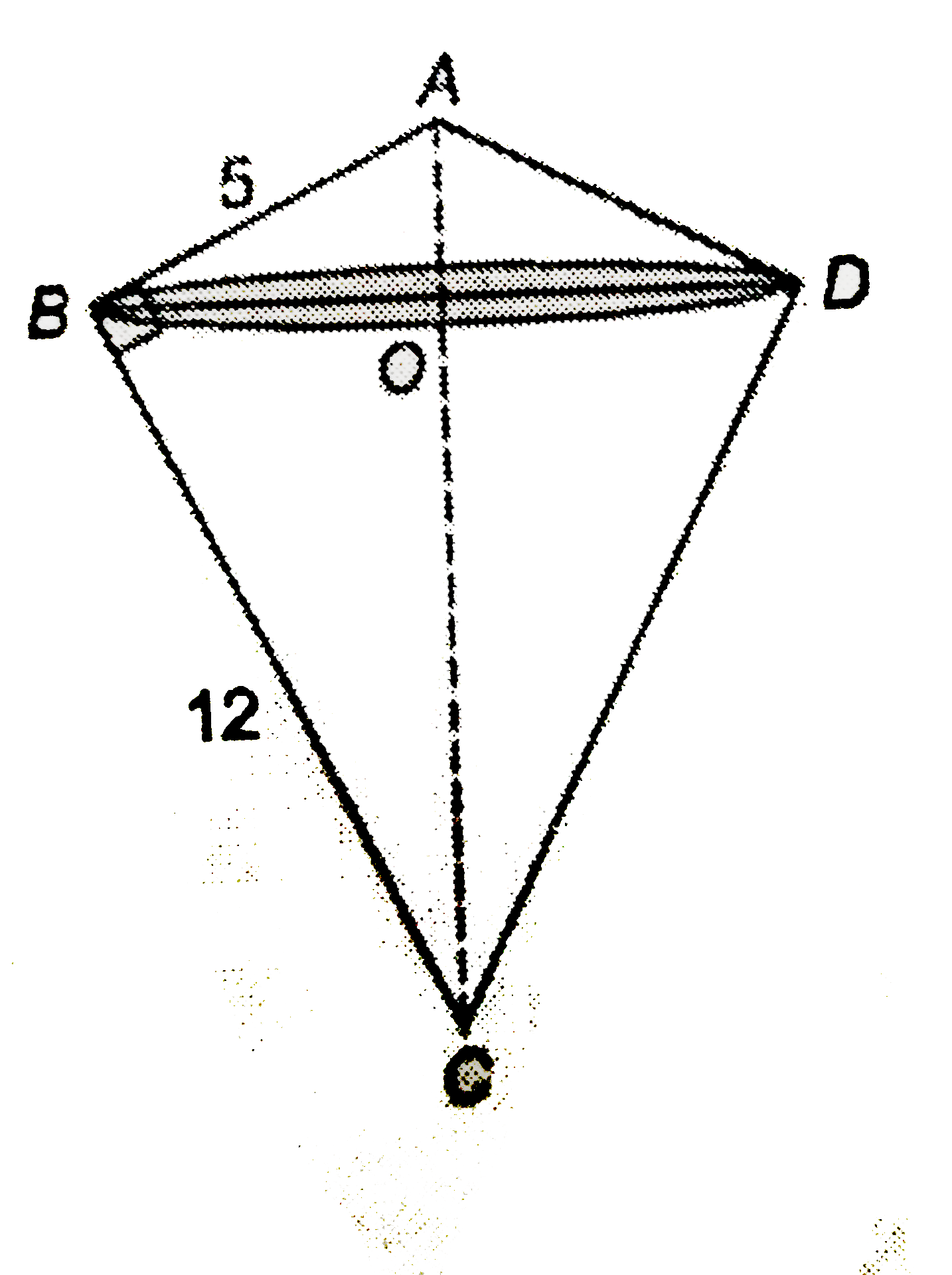The sides containing right angles of a right angled triangle are 8 cm and 6 cm. It is rotated about its hypotenus. Find the volume and total surface area of the formed solid.
To solve the problem of finding the volume and total surface area of the solid formed by rotating a right-angled triangle about its hypotenuse, we can follow these steps:
Step 1: Identify the sides of the triangle
The sides containing the right angles of the triangle are given as:
- Side 1 (perpendicular) = 8 cm
- Side 2 (base) = 6 cm
Step 2: Calculate the length of the hypotenuse
Using the Pythagorean theorem:
Hypotenuse(c)=√(a2+b2)=√(82+62)=√(64+36)=√100=10 cm
Step 3: Calculate the radius of the cone formed
When the triangle is rotated about the hypotenuse, the radius R of the cone can be calculated using the formula:
R=a×bc
Substituting the values:
R=8×610=4810=4.8 cm
Step 4: Calculate the height of the cone
The height H of the cone is the length of the side opposite the hypotenuse, which is the same as the other leg of the triangle. Here, we can consider the height as the length of the side not used in calculating the radius:
H=6 cm(or 8 cm, depending on orientation)
Step 5: Calculate the volume of the cone
The volume V of a cone is given by the formula:
V=13πR2H
Using R=4.8 cm and H=6 cm:
V=13×227×(4.8)2×6
Calculating (4.8)2=23.04:
V=13×227×23.04×6
V=13×22×23.04×67
Calculating 22×23.04×6=3038.88:
V=3038.8821≈723.456 cm3
Step 6: Calculate the total surface area of the cone
The total surface area A of a cone is given by:
A=πRL+πR2
Where L is the slant height of the cone. The slant height can be found using the Pythagorean theorem:
L=√R2+H2=√(4.8)2+(6)2=√23.04+36=√59.04≈7.68 cm
Now substituting the values into the surface area formula:
A=227×4.8×7.68+227×(4.8)2
Calculating each part:
1. πRL=227×4.8×7.68≈88.32
2. πR2=227×23.04≈72.00
Adding these together:
A≈88.32+72.00≈160.32 cm2
Final Answers
- Volume of the cone: 723.456 cm3
- Total surface area of the cone: 160.32 cm2
The sides containing the right angles of the triangle are given as:
- Side 1 (perpendicular) = 8 cm
- Side 2 (base) = 6 cm
Using the Pythagorean theorem:
Hypotenuse(c)=√(a2+b2)=√(82+62)=√(64+36)=√100=10 cm
When the triangle is rotated about the hypotenuse, the radius R of the cone can be calculated using the formula:
R=a×bc
Substituting the values:
R=8×610=4810=4.8 cm
The height H of the cone is the length of the side opposite the hypotenuse, which is the same as the other leg of the triangle. Here, we can consider the height as the length of the side not used in calculating the radius:
H=6 cm(or 8 cm, depending on orientation)
The volume V of a cone is given by the formula:
V=13πR2H
Using R=4.8 cm and H=6 cm:
V=13×227×(4.8)2×6
Calculating (4.8)2=23.04:
V=13×227×23.04×6
V=13×22×23.04×67
Calculating 22×23.04×6=3038.88:
V=3038.8821≈723.456 cm3
The total surface area A of a cone is given by:
A=πRL+πR2
Where L is the slant height of the cone. The slant height can be found using the Pythagorean theorem:
L=√R2+H2=√(4.8)2+(6)2=√23.04+36=√59.04≈7.68 cm
Now substituting the values into the surface area formula:
A=227×4.8×7.68+227×(4.8)2
Calculating each part:
1. πRL=227×4.8×7.68≈88.32
2. πR2=227×23.04≈72.00
A≈88.32+72.00≈160.32 cm2
- Volume of the cone: 723.456 cm3
- Total surface area of the cone: 160.32 cm2
Topper's Solved these Questions
- SURFACE AREA AND VOLUMEBOOK - NAGEEN PRAKASHAN ENGLISHCHAPTER - SURFACE AREA AND VOLUMEEXERCISE - Exercise 13d
20 Videos
- SURFACE AREA AND VOLUMEBOOK - NAGEEN PRAKASHAN ENGLISHCHAPTER - SURFACE AREA AND VOLUMEEXERCISE - Revision Exercise (very Short Answer Questions)
17 Videos
- SURFACE AREA AND VOLUMEBOOK - NAGEEN PRAKASHAN ENGLISHCHAPTER - SURFACE AREA AND VOLUMEEXERCISE - Exercise 13b
2 Videos
- STATISTICSBOOK - NAGEEN PRAKASHAN ENGLISHCHAPTER - STATISTICSEXERCISE - Revision Exercise
12 Videos
- TRIANGLESBOOK - NAGEEN PRAKASHAN ENGLISHCHAPTER - TRIANGLESEXERCISE - Revision Exercise (long Answer Type Question)
8 Videos
Similar Questions
The sides containing right angles of a right angled triangle are 8 cm and 6 cm it is rotated about its hypotenuse . Find the volume and total surface area of the solid formed.
View SolutionThe sides containing right angle of a right angled triangle are 8 cm and 6 cm. It is rotated about the side of 8 cm. Find the total surface area of the formed solid.
View SolutionA Right triangle whose sides are 15 cm and 20 cm; is made to revolve about its hypotenuse. Find the volume and surface area of the double cone so formed.
View SolutionIn a right angle, the sides conrtaining right angles are 5 cm and 12 cm. It is rotated aboutits hypotenuse taking it as axis. Find the volume of formed figure.

View SolutionA right angle triangle with sides 3 cm and 4 cm is revolved around its hypotenuse . Find the volume of the double cone thus generated.
View SolutionA right triangle with sides 6 cm, 8 cm and 10 cm is revolved about the side 8 cm. Find the volume and the curved surface of the solid so formed.
View SolutionA right triangle, whose sides are 3 cm and 4 cm (other than hypotenuse) is made to revolve about its hypotenuse. Find the volume and surface area of the double cone so formed.
View SolutionA right triangle, whose sides are 3 cm and 4 cm (other than hypotenuse) is made to revolve about its hypotenuse. Find the volume and surface area of the double cone so formed.
View SolutionThe radius of the base and the height of a right circular cone are 7 cm and 24 cm respectively. Find the volume and the total surface area of the cone.
View SolutionFrom a solid cylinder whose height is 16 cm and radius is 12 cm, a conical cavity of height 8 cm and of base radius 6 cm is hollowed out. Find the volume and total surface area of the remaining solid.
View Solution
